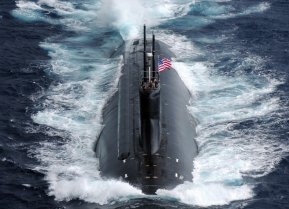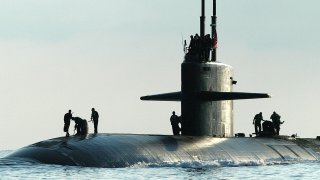Los Angeles-Class Submarine: The U.S. Navy's Legendary Attack Sub
In order to fulfill its role as an attack sub, the Los Angeles class is outfitted with 25 torpedoes launched from four tubes. These horizontal tubes can also launch both Tomahawk land-attack cruise missiles (TLAMs) and Harpoon anti-ship missiles.
Throughout the Cold War, the U.S. and the Soviet Union engaged in arms races across various industries and technologies. One of the most fascinating races was for dominance beneath the waves as each country pressed on with secretive submarine development. The Los Angeles-class of fast attack submarines was one child of this competition and still silently stalks the seas today.
A Brief History of the Los Angeles-class
By the 1960s, nuclear-powered submarines were ubiquitous among the U.S. and Soviet navies. This emerging technology allowed subs to travel great distances at speed and remain submerged at sea for extended periods.
Such subs presented distinct challenges to naval doctrine, particularly the concept of carrier strike groups. Brand new Soviet fast attack subs could penetrate a carrier’s destroyer screens. At the same time, planners worried that missile subs could get close enough to launch a large barrage capable of overwhelming the battle group’s defenses.
The Los Angeles-class responded to these concerns, designed to hunt down enemy subs before they could strike U.S. surface ships.
Design and Capabilities
Dubbed the “688s” after the hull number of the USS Los Angeles, first in class, these subs feature several critical upgrades over their predecessors, the Sturgeon class boats. Most notably, the S6G Pressurized Water Reactor is larger and more powerful.
This gives the subs a higher top speed - the official U.S. Navy number is over 25 knots; however, some have estimated it may be as high as the mid-30s - while sacrificing diving depth.
While planners initially decried the need for speed, claiming stealth was more important, a 1968 incident in which the carrier USS Enterprise could not outrace a Soviet submarine swiftly convinced them otherwise.
Coupled with acoustic reduction technology designed using lessons learned from the preceding decades, at launch, the 688s were faster and quieter than their predecessors and able to compete with their Soviet counterparts.
In order to fulfill its role as an attack sub, the Los Angeles class is outfitted with 25 torpedoes launched from four tubes. These horizontal tubes are also capable of launching both Tomahawk land-attack cruise missiles (TLAMs) and Harpoon anti-ship missiles.

Later, boats were outfitted with 12 vertical launch tubes for firing TLAMs. While this is no match for the 154 TLAMs on an Ohio class SSGN, it still packs a powerful offensive punch.
More details surrounding the Los Angeles-class’ armaments has been noted by Naval Technology: “The submarine is fitted with four 533mm torpedo tubes located midships together with a Mark 117 torpedo fire control system. The submarine has the capacity for 26 torpedo tube launched weapons including Tomahawk missiles, Harpoon missiles and Mark 48 ADCAP torpedoes. The Gould Mark 48 torpedoes combat both high-performance surface ships and fast deep-diving submarines. The torpedo is capable of operating with or without wire guidance and uses either or both active and passive homing. It is equipped with multiple re-attack modes which operate if the target ship is missed. The torpedo carries out programmed target search, acquisition and attack procedures.”
Cover Operations
During the Cold War, submarines were involved in spy capers straight out of a James Bond film, such as tapping an undersea telephone cable next to a Russian base. Many such capers remain classified, as do the missions of submarines today.
While they may not carry out such wild acts, 688s are well-equipped for Intelligence, Surveillance, and Reconnaissance (ISR) missions.
Their quiet signature allows them to approach close to adversary vessels and shorelines where they can intercept communications and obtain imagery of various targets. Further, many are capable of equipping a SEAL Delivery Vehicle.
This manned swimmer delivery submersible allows U.S. Navy SEALs to access denied areas covertly. The silent Los Angeles is able to slip in close to shore where the SEALs make their final approach.
What is the future of the LA Class?
In total, 62 Los Angeles class boats were built, the most of any submarine class in the world. These included the original 688 boats, the Flight II improved design, and the Flight II 688i (for improved) model, which featured retractable bow planes and a reinforced sail for under-ice operations.
Of these, 24 remain in active service, with the majority of the rest having been decommissioned or fully recycled. Two boats, the USS San Francisco and La Jolla, have been converted to moored training ships.
While the Seawolf class and newer Virginia class will ultimately fully take on the mantle of the Navy’s fast attack subs, for now, the 688s will continue to serve with distinction.
Maya Carlin is an analyst with the Center for Security Policy and a former Anna Sobol Levy Fellow at IDC Herzliya in Israel. She has by-lines in many publications, including The National Interest, Jerusalem Post, and Times of Israel. You can follow her on Twitter: @MayaCarlin.
Main Image Credit: Souda Bay, Crete, Greece (Oct. 14, 2005) - The Los Angeles-class fast attack submarine USS Philadelphia (SSN 690) arrives in Souda Harbor for a routine port visit to Greece's largest island. Philadelphia is homeported in Groton, Conn., and began a scheduled deployment in June 2005. U.S. Navy photo by Mr. Paul Farley (RELEASED).
Intext Images are Creative Commons.


